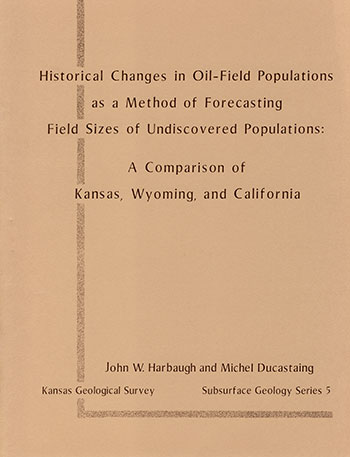Historical Changes in Oil-field Populations as a Method of Forecasting Field Sizes of Undiscovered Populations: A Comparison of Kansas, Wyoming, and California
DOI:
https://doi.org/10.17161/kgsbulletin.no..23609Abstract
This study involves analysis of historical changes in oil-field sizes in Kansas, Wyoming, and California. It is common knowledge that large oil or gas fields tend to be found early in the sequence of discoveries in a region, and that the sizes of fields tend to diminish progressively as exploration proceeds. This study has found that populations of oil fields (or oil and gas fields combined) tend to be more or less lognormally distributed; but in some regions or districts, the populations of fields discovered early tend to depart more severely from an ideal lognormal distribution than do populations discovered later. Comparisons between populations of fields discovered early, intermediately, and late were made by segregating the presently known fields in each of the three states into intervals representing the first 20 percent to be discovered, the second 20 percent to be discovered, and so on. This method of segregating by discovery sequence also was employed for individual districts within each state.
The results are presented graphically and in tables, and may be used to predict the population parameters of fields to be discovered in the future. In most of the districts, as well as for each state, the forecasts of new-field discoveries are pessimistic. This pessimism stems from the rapid decline in population parameters (median, geometric mean, and total volume) with the progression of discoveries. It is to be emphasized that these predictions pertain to the discovery of new fields, and exclude increases in oil and gas that may result from extensions of known fields, or from enhanced oil and gas recovery in existing fields. Furthermore, the forecasts pertain to general regions of already-discovered fields and exclude provinces (such as offshore central and northern California) that have been relatively little explored.
In California, it is estimated that, of the next 81 fields to be discovered (within the established oil- or gas-bearing regions of California), the total volume of oil and gas (expressed as barrels of oil equivalent, or BOE) will be about 0.6 percent of the total hydrocarbons that ultimately will be extracted from California's total of 404 fields discovered from 1861 through 1974. Furthermore, this forecast population is estimated to be approximately lognormally distributed, with a median size of only 125,000 BOE. Given the graph of this forecast distribution, probabilities attached to individual field-size ranges (in BOE) can be estimated. Within the forecast population of 81 fields, for example, the probability is only nine percent that any particular field discovered will be between 10 and 100 million BOE. The probability of finding a field greater than 100 million BOE is only a small fraction of one percent.
In Wyoming, the forecast of the next 151 fields to be discovered is only slightly less pessimistic. It is forecast that this population of new fields will contribute only about 1.6 percent additional BOE relative to the total BOE extractable from the 754 fields discovered in Wyoming from 1884 through 1977.
The data for Kansas exclude gas and are based on cumulative production of oil through the end of 1978 for all fields discovered through the end of 1973. Thus, the oil-field size distributions for Kansas (in contrast to Wyoming and California) are somewhat inadequate measures for forecasting purposes because they exclude estimates of remaining reserves. Thus, because many Kansas fields are still producing, the population parameters must be revised upward. Nevertheless, the forecast for new-field discoveries in Kansas is pessimistic. By comparison with the total of 2,992 oil fields discovered in Kansas from 1890 through 1973, if 598 new fields are discovered (20 percent more) they probably will contribute only two or three percent more to the oil discovered in Kansas through 1973.

Downloads
Published
Issue
Section
License
Copyright (c) 2025 John W. Harbaugh, Michel Ducastaing

This work is licensed under a Creative Commons Attribution-NonCommercial 4.0 International License.
